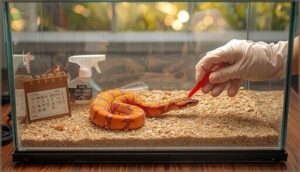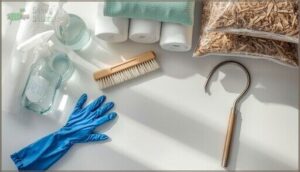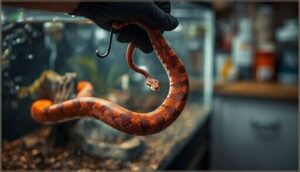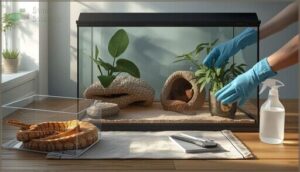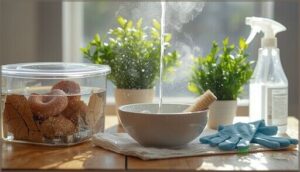This site is supported by our readers. We may earn a commission, at no cost to you, if you purchase through links.

Most keepers underestimate how fast pathogens colonize warm, humid environments, putting their snakes at risk for scale rot and respiratory infections. The difference between a thriving corn snake and a sick one often comes down to a consistent cleaning routine.
This guide walks you through the entire process, from safely removing your snake to restoring ideal temperature gradients after disinfection.
Table Of Contents
- Key Takeaways
- Step-by-Step Corn Snake Habitat Cleaning
- Preparing and Disinfecting Habitat Components
- Maintaining Temperature and Humidity After Cleaning
- Health and Hygiene Tips for Corn Snakes
- Top 3 Products for a Clean Corn Snake Habitat
- Frequently Asked Questions (FAQs)
- How do you clean a corn snake habitat?
- Are corn snakes easy to care for?
- How does a corn snake care sheet work?
- How often should you clean a corn snake’s habitat?
- How do you treat a corn snake?
- How do you keep a corn snake scaly?
- Can I use vinegar to clean snake tanks?
- How to prevent bacterial growth between deep cleans?
- What odors indicate a dirty corn snake habitat?
- Should I clean during shedding or feeding cycles?
- Conclusion
Key Takeaways
- Daily spot-cleaning and monthly deep-cleaning prevent bacterial buildup that leads to scale rot and respiratory infections, making consistent maintenance the single most critical factor in corn snake health.
- Proper disinfection requires reptile-safe solutions (F10SC, chlorhexidine, or diluted vinegar), thorough rinsing, and complete drying before reintroducing your snake—harsh chemicals leave invisible residues that damage respiratory systems and skin.
- Temperature and humidity must be restored to precise levels after cleaning (90°F basking zone, 75°F cool zone, 40-50% humidity) before returning your snake, as environmental instability during reintroduction causes stress and compromises immune function.
- Recognizing early warning signs like foul odors, visible waste accumulation, or respiratory symptoms allows you to intervene before minor hygiene issues escalate into serious veterinary emergencies.
Step-by-Step Corn Snake Habitat Cleaning
Keeping your corn snake’s home clean isn’t rocket science, but doing it right makes all the difference for your snake’s health. A clean habitat prevents infections like scale rot and keeps your pet thriving for years to come.
Let’s walk through exactly how to tackle both quick daily maintenance and those deeper monthly cleanings.
How Often to Clean a Corn Snake Enclosure
You don’t want to clean your corn snake’s home too often—or too rarely—so let’s nail down the right schedule for both daily upkeep and those deeper scrub-downs.
Spot-clean your enclosure daily by removing waste and soiled substrate to prevent scale rot and maintain proper humidity control.
A full deep clean with safe disinfectants should happen every 4-6 weeks, depending on your snake’s size and activity level—this ensures solid reptile care and keeps enclosure maintenance manageable without stressing your snake.
Tools and Supplies You’ll Need
Before you start scrubbing anything down, gather your cleaning arsenal—having everything within arm’s reach makes the job faster and keeps your snake’s downtime to a minimum.
Double-check that heating elements are unplugged before you begin.
Here’s what you’ll need for proper enclosure maintenance:
- Reptile-safe cleaning solutions (10:1 water-to-bleach or commercial reptile disinfectant)
- Snake hooks for gentle relocation
- Scrub brushes and paper towels for habitat decor and glass
- Fresh substrate options (aspen shavings or cypress mulch)
- Spray bottle and gloves for applying disinfectant safely
Removing Your Snake Safely
Once your supplies are lined up, the next move is getting your corn snake out of its enclosure without spooking it or risking a nip. Approach from the side—never from above—and use a snake hook if your corn snake is skittish. Support its body gently along its length, avoiding the tail or head restraint. Move slowly and confidently.
| Safe Removal Step | What to Do | Why It Matters |
|---|---|---|
| Approach angle | Come from the side, not overhead | Prevents defensive striking response |
| Snake hook use | Slide under mid-body section | Reduces stress during initial contact |
| Gentle restraint | Support body weight evenly | Keeps snake calm and secure |
| Escape prevention | Transfer to secure container with air holes | Stops wandering during habitat cleaning |
Place your snake in a ventilated container while you work.
Spot Cleaning Vs. Deep Cleaning
Not every cleaning session needs to be a full production—you’ll want to know the difference between a quick spot clean and a total habitat overhaul. Spot cleaning means daily waste removal and sanitizing soiled substrate areas, which keeps your corn snake habitat fresh between deep cleans.
Deep cleaning involves complete substrate changes, disinfecting all decor, and resetting your entire habitat setup.
Follow cleaning schedules based on your snake’s needs—spot clean daily, deep clean monthly for proper reptile care and maintenance.
Step-by-Step Deep Cleaning Instructions
When it’s time for a full reset, you’ll want to follow these six steps to get your corn snake’s habitat properly sanitized and ready to go. Snake safety comes first, so relocate your snake to a secure temporary enclosure. Then:
- Remove all substrate, hides, and decor
- Disinfect the enclosure with reptile-safe cleaner
- Rinse thoroughly and dry completely
Preparing and Disinfecting Habitat Components
Once you’ve cleared out the dirty substrate and wiped down the enclosure, it’s time to tackle the individual pieces that make your corn snake’s habitat feel like home.
Each component—from hides to water bowls—needs proper cleaning to prevent bacteria buildup and keep your snake healthy. Here’s how to prepare and disinfect everything before setting up the habitat again.
Cleaning and Disinfecting Hides and Decor
Your snake’s hides and décor don’t just collect dust—they become magnets for bacteria, stuck shed, and fecal matter that can quickly turn a safe haven into a health hazard.
Remove all hides and decor from the enclosure, then scrub them with hot water and a reptile-safe disinfectant. Rinse thoroughly to eliminate any chemical residue, and let everything air-dry completely before placing it back in your corn snake habitat.
Washing and Refilling Water Bowls
Stale water isn’t just unappetizing—it’s a breeding ground for harmful bacteria that can make your corn snake sick within days. Here’s your water bowl cleaning routine for ideal snake hygiene:
- Empty and scrub daily with hot water and a reptile-safe disinfectant
- Rinse thoroughly to remove all chemical residue before refilling
- Replace water daily to maintain hydration and water quality
- Use a heavy, shallow dish that won’t tip during soaking
- Inspect for cracks and replace damaged bowls immediately
Properly Changing and Disposing of Substrate
Old substrate doesn’t just sit there harmlessly—it collects bacteria, mold spores, and waste that can silently compromise your corn snake’s immune system over time.
Here’s how to manage substrate removal: scoop out soiled bedding daily during spot cleaning, then completely replace all substrate every 4-6 weeks during deep cleaning. Seal used substrate in plastic bags before disposal to prevent contamination.
Whether you’re using aspen shavings or cypress mulch, proper waste disposal protects your snake’s respiratory health and prevents scale rot.
Safe Disinfectants for Reptile Habitats
Choosing the wrong cleaner can do more harm than scrubbing with dirty water—harsh chemicals leave invisible residues that irritate your corn snake’s skin and respiratory system every time it moves through the enclosure.
Stick with reptile-safe disinfectants specifically formulated for animal facility maintenance:
- F10SC veterinary disinfectant – trusted in reptile care for eliminating pathogens without toxic fumes
- Chlorhexidine solution (0.5%) – gentle habitat sanitizer that rinses clean
- Plain white vinegar (diluted 1:1) – pet safe cleaner for routine snake habitat maintenance
Always rinse thoroughly and let surfaces dry completely before reintroducing your corn snake.
Maintaining Temperature and Humidity After Cleaning
Once your enclosure is clean and dry, you’ll need to restore the right environmental conditions before returning your snake.
Getting the temperature gradient and humidity back to species-appropriate levels isn’t complicated, but it does require a methodical approach.
Let’s walk through how to reset your heating equipment, verify your climate zones, and confirm everything’s stable.
Resetting Heat Mats and Lighting
Once the enclosure is cleaned and dried, plugging your heat mat back in and turning on your lighting system brings the habitat back to life—but you’ll want to double-check that everything’s functioning properly before your snake returns home.
Test your thermostat settings to verify the heat mat reaches the correct basking temperature of 90°F. Your lighting cycles should restore the day-night schedule, supporting your corn snake’s natural crepuscular behavior and overall reptile care routine.
Monitoring Temperature Zones
After you’ve confirmed the heat is working, grab your thermometer and check all three temperature zones—you want that basking spot hitting 90°F, the ambient area sitting at 78–82°F, and the cool side staying around 75°F. Proper thermal gradients let your snake thermoregulate naturally, moving between heat sources as needed for digestion and activity.
Key zone management checkpoints:
- Place thermometers at substrate level where your snake actually rests, not mid-air
- Monitor ambient temperature in the enclosure’s center for accurate readings
- Verify heat sources maintain consistent output after reconnecting equipment
- Check your thermostat settings to prevent overheating or cold spots
- Wait 30–60 minutes after setup for temperature control to stabilize before reintroducing your corn snake
Adjusting Humidity and Using Moist Hides
Humidity matters just as much as heat, especially when your corn snake’s about to shed. Aim for that 40–50% baseline, but don’t be afraid to bump it up with a moist hide or strategic water bowl placement when you notice cloudy eyes or dull scales.
You can create humid microclimates by placing moist hide boxes over your under-tank heater, which naturally boosts snake hydration through gentle evaporation while maintaining overall humidity levels throughout your Corn Snake Habitat.
Checking Thermostats and Hygrometers
The numbers don’t lie—your gauges need a quick check every time you clean, because even small drifts in temperature or humidity can throw off your snake’s comfort zone without you noticing. Here’s what to verify:
- Thermostat settings match your target temperature gradient (90°F basking, 75°F cool zone)
- Heating elements respond properly when the reptile thermostat cycles on and off
- Hygrometer readings confirm 40–50% humidity levels throughout the enclosure
- Temperature control sensors sit flush against surfaces, not dangling in midair
- Sensor calibration accuracy by cross-checking with a backup thermometer
Health and Hygiene Tips for Corn Snakes
A clean habitat is your first line of defense against illness, but even the best cleaning routine needs backup from smart hygiene habits. Knowing what to watch for and when to act can mean the difference between a quick fix and a serious health crisis.
Here’s how to keep your corn snake healthy, recognize trouble early, and manage them safely through every cleaning session.
Preventing Scale Rot and Respiratory Infections
You can’t build a fortress on swampy ground—and your corn snake’s health depends on keeping moisture and bacteria in check. Scale Rot Prevention starts with maintaining humidity between 40–50%, since levels above 60% increase scale rot cases by 35%. Respiratory Health thrives in well-ventilated habitats with stable temperature gradients.
Proper Humidity Control, clean substrate, daily waste removal, and Snake Nutrition with vitamin supplementation strengthen Infection Management naturally, protecting your reptile from the most common health and hygiene threats. Effective humidity management involves understanding optimal humidity levels to guarantee a healthy environment.
Recognizing Signs of Poor Hygiene
Vigilance against poor hygiene means spotting trouble before it escalates. Your corn snake’s enclosure can quietly signal health problems through environmental changes that directly affect reptile health issues and overall well-being.
- Dirty substrate with visible waste, mold growth, or compacted material creates bacterial breeding grounds
- Foul odors indicate decomposing material, poor shedding debris, or scale rot developing beneath scales
- Respiratory issues like wheezing or mouth-breathing often stem from excessive humidity and poor ventilation affecting snake habitat and diet quality
Regular maintenance is vital to prevent diseases, and understanding corn snake care is essential for a healthy environment.
Safe Handling During and After Cleaning
Proper management techniques protect both you and your snake from unnecessary stress when the enclosure demands attention. Always approach snake removal from the side, supporting the body fully to prevent defensive strikes. Wait 48 hours post-feeding before any animal management and safety measures.
| Management Phase | Safety Precautions |
|---|---|
| Pre-Cleaning | Move snake to secure temporary container; avoid management during shed cycles |
| During Cleaning | Keep snake in ventilated holding space; maintain ambient temperature 75-82°F |
| Post Cleaning Care | Allow new substrate to settle; verify temperature zones before reintroduction |
| Return Protocol | Place snake gently; monitor snake behavior for 24 hours for stress indicators |
Understanding cleaning protocols alongside proper management techniques minimizes reptile health issues and ensures your corn snake’s care and maintenance routine stays stress-free.
When to Consult a Reptile Veterinarian
Recognizing when your corn snake needs professional veterinary care can mean the difference between a quick fix and a serious health crisis. Schedule annual wellness visits with reptile experts for health checks and fecal screenings, but watch for urgent snake emergencies that demand immediate medical guidance.
- Respiratory distress – Open-mouth breathing, wheezing, or profuse discharge from the mouth signals a critical condition requiring same-day reptile health intervention.
- Severe skin issues – Blisters, ulcerations, burns, or visible parasites like mites indicate infections that compromise your corn snake’s wellbeing.
- Behavioral red flags – Sudden lethargy, repeated feeding refusals, seizures, or prolapse are snake care emergencies needing prompt reptile veterinary attention.
Top 3 Products for a Clean Corn Snake Habitat
Keeping your corn snake’s home clean doesn’t have to be complicated when you’ve got the right gear. The three products below can make a real difference in maintaining proper hygiene and reducing cleaning time.
Let’s look at what actually works for everyday habitat maintenance.
1. Reptile glass terrarium tank enclosure
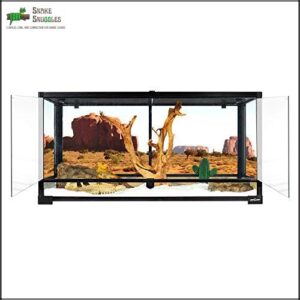
For reptile housing, glass enclosures like the REPTI ZOO 50-gallon terrarium offer a winning combination of visibility and functionality for your corn snake habitat. This tank setup features mesh sides for proper ventilation and UVB penetration, plus a waterproof bottom that manages both spot cleaning and deep disinfecting without leaking—critical for preventing scale rot.
The double-hinge front doors make feeding and enclosure security a breeze, while the raised frame accommodates under-tank heaters for maintaining those essential temperature zones.
Though glass terrariums require careful assembly and monitoring for condensation, their non-porous surfaces simplify tank maintenance markedly compared to wooden alternatives.
Best For: Reptile owners seeking a spacious, well-ventilated glass enclosure for corn snakes or similar semi-arboreal species who value easy access and visibility.
- Mesh ventilation and waterproof base support proper airflow and humidity control while preventing leaks and simplifying cleaning routines.
- Double front doors open separately for safe feeding without escape risks, plus raised frame fits substrate heaters for maintaining temperature gradients.
- Non-porous glass surfaces allow quick spot cleaning and full disinfection, making maintenance easier than wood or melamine alternatives.
- Glass loses heat quickly and may need higher-wattage bulbs or extra heat sources to maintain ideal basking zones of 88–92°F.
- Assembly can be tricky and may result in wobbling if not done carefully, plus no door handles makes opening awkward without tools.
- Side screen panels make achieving very high humidity difficult, and glass panels risk arriving broken despite careful packaging.
2. Coconut Husk Reptile Bedding Block
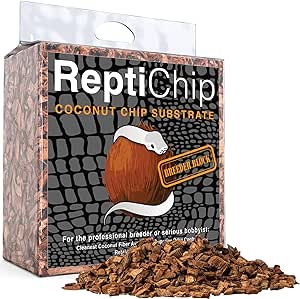
When coconut husk bedding holds up to ten times its weight in water, you’re looking at a substrate that practically runs your humidity control methods on autopilot. This 100% organic reptile bedding option maintains 50-70% humidity for your corn snake habitat while absorbing waste odors—ammonia stays around 3.2 ppmv versus 7.8 in wood shavings.
You’ll spot-clean every 3-7 days and replace the substrate every 4-12 weeks, cutting maintenance time by 30%.
The chunky texture facilitates natural burrowing behavior in your tank setup and works perfectly for bioactive enclosures since it resists mold growth by 92% compared to soil mixes.
Best For: Corn snake owners who want natural, low-maintenance bedding that keeps humidity stable and odors down without constant fussing.
- Holds up to 10x its weight in water, keeping enclosure humidity at 50-70% for weeks with minimal misting
- Cuts odor significantly—ammonia stays around 3.2 ppmv compared to 7.8 in wood shavings, with 73% of owners reporting noticeable smell reduction
- Supports natural burrowing and exploration while resisting mold 92% better than soil mixes, making it ideal for bioactive setups
- Can be dusty when you first expand the brick, so you might want a mask handy
- Takes some care to water correctly—too much leads to mold, too little defeats the humidity purpose
- Runs $34.95, which is pricier upfront than basic options, though it lasts 4-12 weeks between full changes
3. Warm Hydroponic Seedling Heat Mat
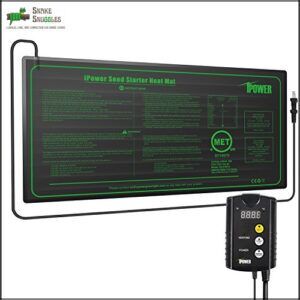
Your corn snake housing demands precise temperature gradient control—75°F on the cool end and 90°F basking surface—and this 10″ × 20″ mat with digital thermostat manages that task perfectly.
Set temperatures between 40-108°F with waterproof, easy-clean construction that prevents bacterial buildup during mat maintenance cycles. Monitor your snake habitat’s temperature zones using the included sensor, while the durable insulated wiring provides heat mat safety during 24/7 operation.
Though marketed for hydroponic systems and seedling growth, the uniform heat distribution works beautifully for maintaining humidity and temperature control in corn snake enclosures.
Best For: Reptile keepers who need precise, reliable temperature control for corn snake enclosures or other small reptile habitats requiring consistent warm zones.
- Digital thermostat with wide temperature range (40-108°F) enables exact control of basking and ambient zones for proper reptile thermoregulation
- Waterproof construction simplifies cleaning and prevents moisture damage in humid reptile environments
- Durable insulated wiring supports safe 24/7 operation needed for continuous reptile heating
- 10″ × 20″ size may be too small for larger enclosures or multiple heating zones without purchasing additional units
- Sensor placement requires careful positioning to accurately measure substrate temperature rather than air temperature
- Marketed for hydroponics rather than reptiles, so setup guidance may not address reptile-specific heating needs
Frequently Asked Questions (FAQs)
How do you clean a corn snake habitat?
You’ve probably noticed your snake’s enclosure looking a bit messy—that’s normal. Cleaning a corn snake habitat involves spot-cleaning waste daily and deep-cleaning every 4-6 weeks to maintain reptile health and proper enclosure security.
Are corn snakes easy to care for?
Yes, corn snakes are beginner-friendly pets. Their docile temperament, straightforward snake care requirements, and predictable corn snake behavior make them ideal for first-time reptile care enthusiasts learning pet snake maintenance and snake management techniques.
How does a corn snake care sheet work?
A care sheet provides species-specific guidelines for reptile care, covering snake habitat design, corn snake diet, temperature ranges, humidity levels, and snake behavior patterns.
It’s your quick reference for pet care tips, reptile health monitoring, and corn snake care and maintenance best practices.
How often should you clean a corn snake’s habitat?
You’ll want to spot clean daily by removing waste and uneaten food, then do a complete deep clean every four to six weeks.
This cleaning schedule maintains ideal reptile hygiene while protecting your corn snake’s health, temperature stability, and humidity levels in the enclosure.
How do you treat a corn snake?
How should you interact with your Corn Snake for ideal Animal Care and Welfare? Gentle, consistent Corn Snake management builds trust—support their body, avoid sudden movements, and skip management during sheds or right after meals.
Regular Reptile Health Checks and proper Snake Nutrition Tips keep them thriving.
How do you keep a corn snake scaly?
Healthy scales depend on proper humidity (40-50%) and consistent hydration.
Your corn snake needs access to fresh water daily for drinking and soaking, which aids healthy shedding and maintains scale health throughout its life.
Can I use vinegar to clean snake tanks?
Diluted white vinegar works well for tank sanitizing, but rinse thoroughly afterward. This natural cleaning solution helps maintain snake welfare without harsh chemicals that could harm your corn snake’s delicate respiratory system.
Mix one part vinegar with one part water for safe reptile health cleaning.
How to prevent bacterial growth between deep cleans?
Between deep cleans, spot-clean daily to remove waste and uneaten food. This Daily Sanitizing prevents Bacterial Testing issues.
Monitor Humidity levels with a hygrometer and maintain proper Temperature ranges—stable conditions limit Microbe Management challenges and keep your Habitat healthier.
What odors indicate a dirty corn snake habitat?
Like smoke signals warning of fire, your nose knows when something’s wrong. A sharp ammonia smell from urine or foul fecal smell means waste buildup. Musty scents signal mold growth or bacterial bloom in your corn snake habitat—especially when humidity and temperature aren’t balanced.
Your nose is the first alarm—ammonia, foul waste, or musty mold signals dangerous bacterial buildup in your corn snake’s habitat
Should I clean during shedding or feeding cycles?
Skip deep cleaning during your corn snake’s shedding cycle or within 48 hours after feeding schedules. Snake stress increases during these times, and habitat maintenance disrupts critical biological processes, affecting humidity needs and overall snake care.
Conclusion
A spotless enclosure prevents disease, but an erratic cleaning schedule invites disaster. Your corn snake thrives when you commit to routine maintenance—spot cleaning daily, deep cleaning monthly, and monitoring temperature zones after every reset.
This cleaning a corn snake habitat guide gives you the blueprint for consistency. When substrate stays fresh, water stays clear, and hides stay sanitized, your snake won’t just survive—it’ll flourish. The work you put in now protects the health you’ll see later.
- https://www.animalsathome.ca/how-to-clean-a-snake-tank/
- https://www.reddit.com/r/cornsnakes/comments/rv6c7v/how_often_do_you_do_a_full_substrate_change/
- https://researchnow.flinders.edu.au/files/100646640/Deliveyne_Recovering_P2022.pdf
- https://reptifiles.com/corn-snake-care-guide/corn-snake-temperatures-humidity/
- https://talis-us.com/blogs/news/corn-snake-heat-mat-temperature-guide

